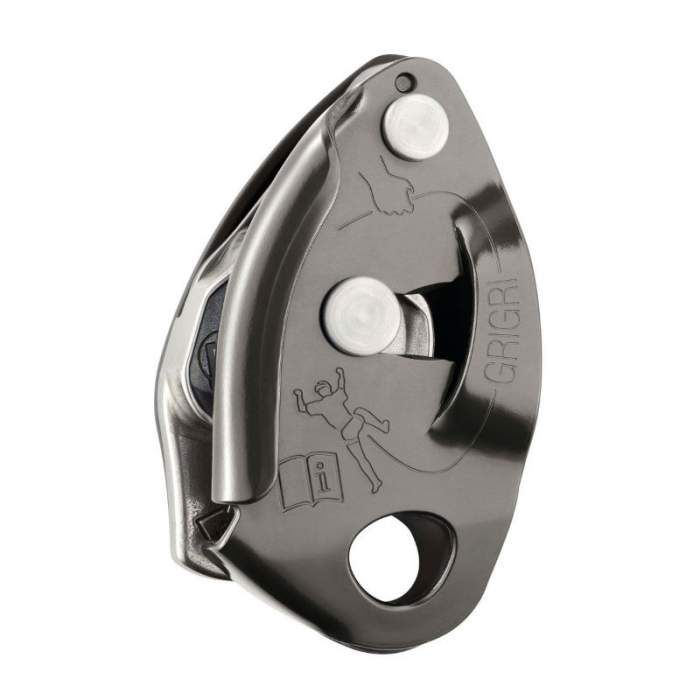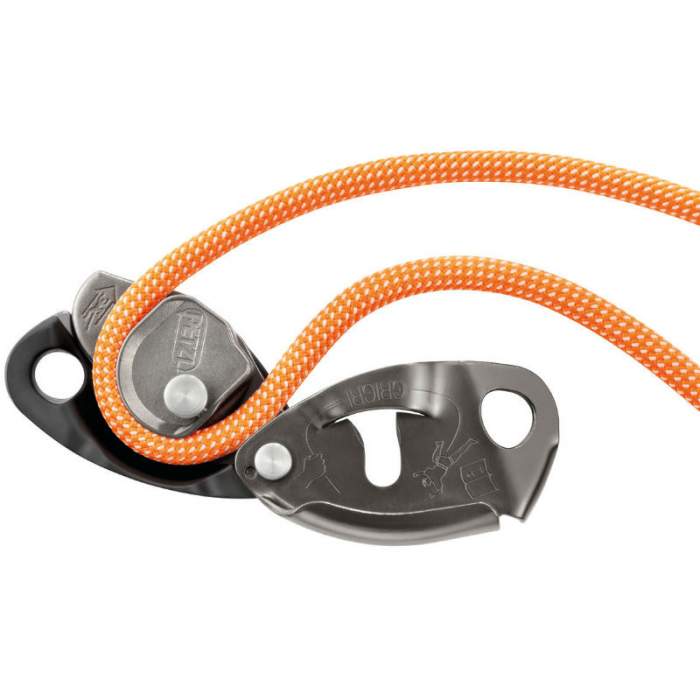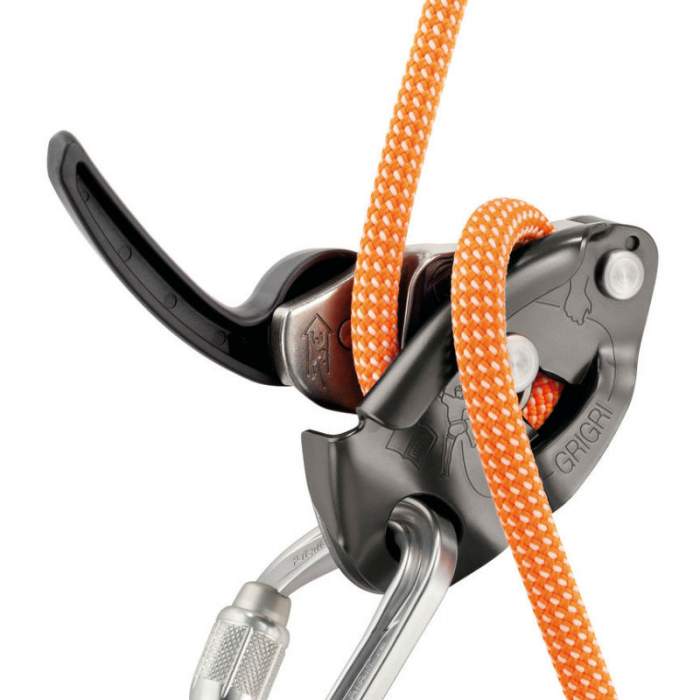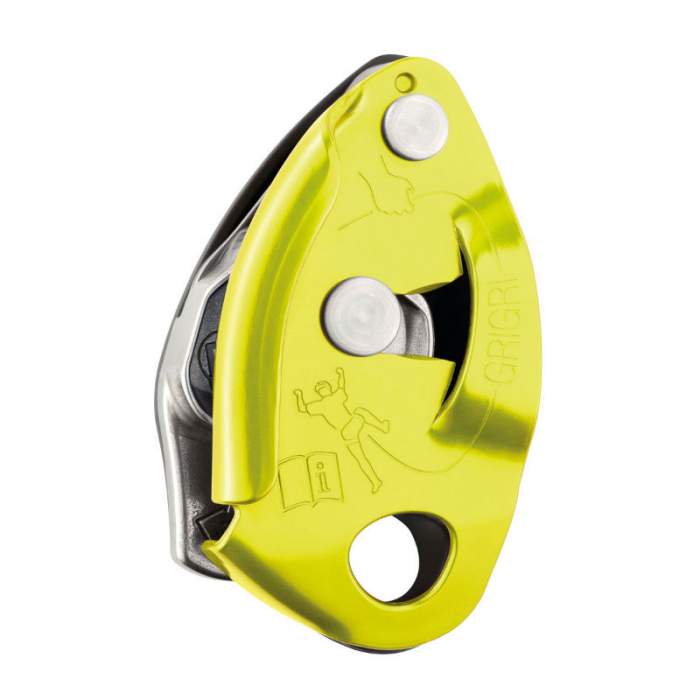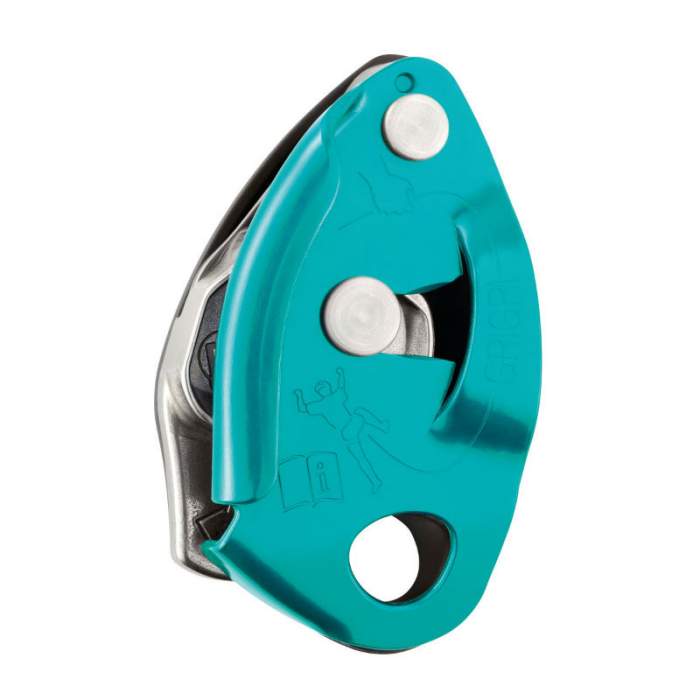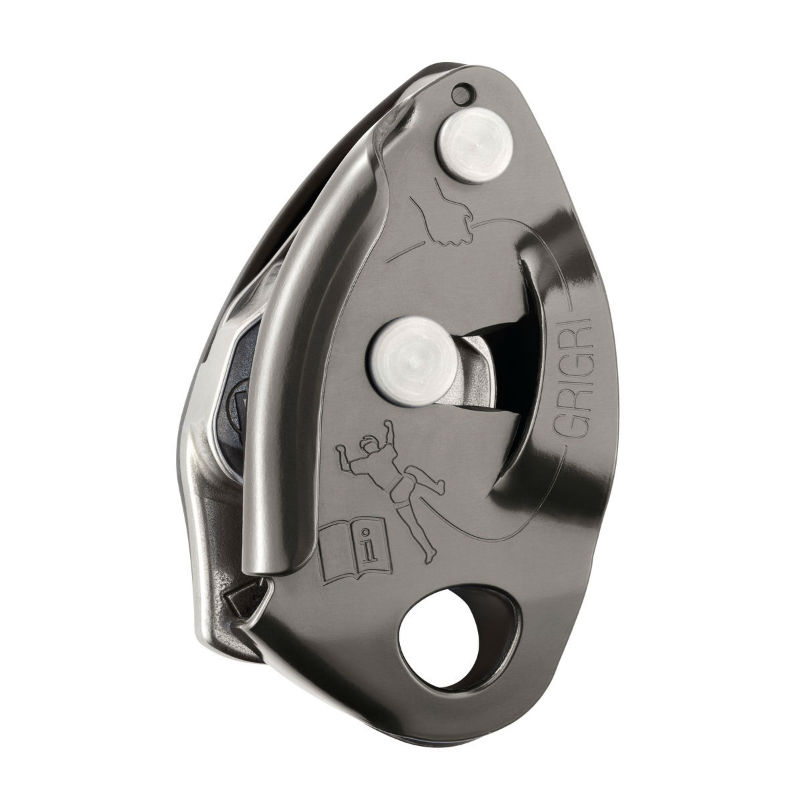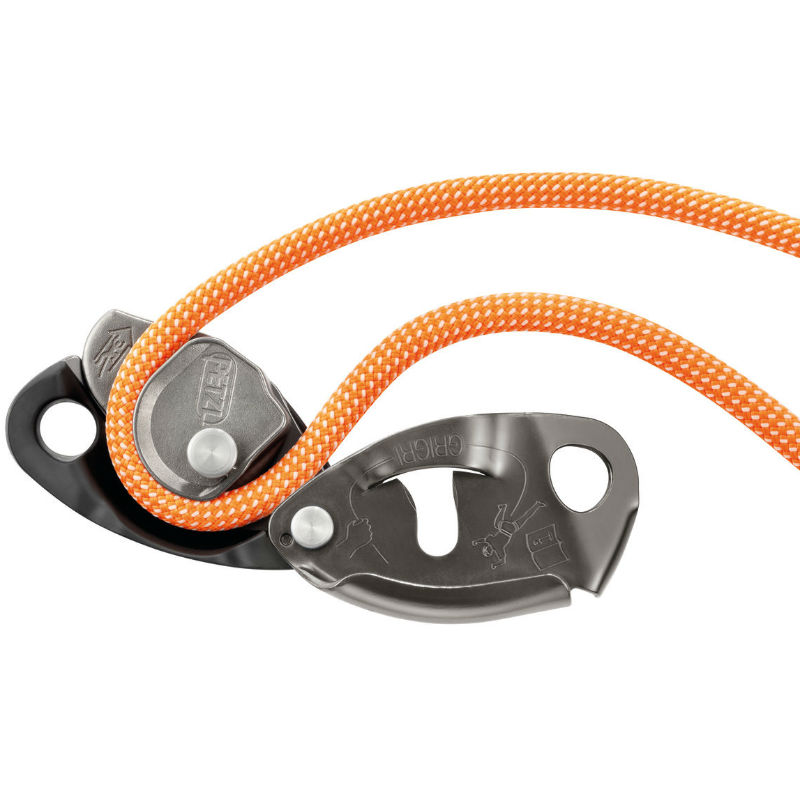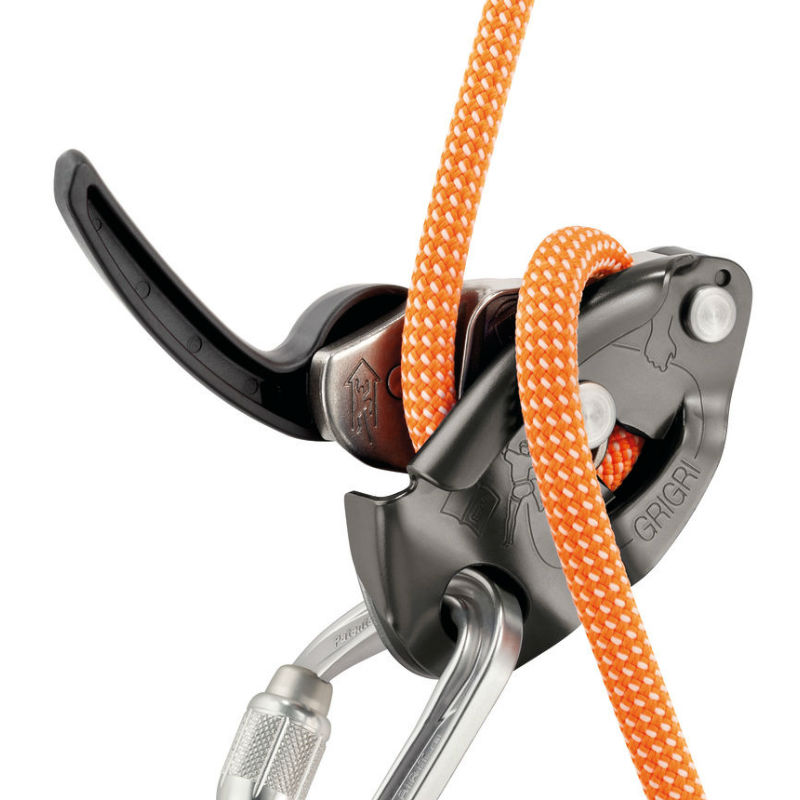GriGri 2
Description
The GRIGRI 2 belay device with assisted braking is designed to facilitate belay maneuvers. The GRIGRI 2 works equally well for lead climbing and top roping. Compact and lightweight, the GRIGRI 2 will accompany you for many years, on climbs all over the world. The GRIGRI 2's design allows for excellent descent control.
Description
Hand motions are the same as with classic belay systems: both hands on the rope. A fall is stopped by gripping the brake side of the rope with your hand.
Assisted braking: during fall arrest, the belayer holds the brake side of the rope, the cam pivots and pinches the rope, increasing the braking action until the rope stops sliding.
The GRIGRI 2's design allows for excellent descent control. One hand holds the rope and the other uses the handle to unlock the cam. The patented handle design allows a very gradual release of the rope. Combined with the strong braking action of the cam, it gives a great feeling of security when lowering a partner or rappelling.
The GRIGRI 2 is compact and very light at 170 g
Built with a stainless steel friction plate and cam to ensure a long life for the product
Diagrams for rope installation engraved on belay device (interior and exterior)
Material(s): aluminum side plates, stainless steel cam and friction plate, reinforced nylon handle.
Retail price
This Product is Hard to Find.
We don’t know where you can buy this item online in the US. We’ll continue to check all the major retailers and will update this page as soon as we find one.
If you know where to find this online in the US, let us know, and we’ll add the link.



Device Type  Device TypeTubeThe most commonly used belay type also called an “ATC” or “tuber.” Other than a distinction between other belay device types, “Tube” is a rarely used term, most climbers just assume you're talking about this style when they refer to your "belay device." 
Figure 8Mostly used in rescue, canyoneering, tactical, work safety, or by old school climbers and rappellers. One reason they went out of popularity with recreational climbers is because they tend to create twists in the rope. 
Brake AssistThese devices assist in stopping the rope when a climber falls or hangs on the rope. 
Often referred to as “auto-blocking” but that’s not the official terminology because no belay device should be assumed to work automatically by itself, even if it feels like it does (or does most the time). PlateWhen simplicity is a must, or you started climbing before Tubers were the norm. Bonus: They tend to be very light weight. 
DescenderFor rappelling, not for belaying a lead climber or top-roping. 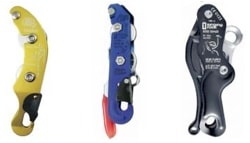 |
Brake Assist - Mechanical |
Weight (g)  Weight (g)In grams, the weight, as stated by the manufacturer/brand. |
170 g |
Belay Brake Assist  Belay Brake AssistThis is when the belay device significantly reduces the amount of holding power the belayer must exert to stop a fall and hold a climber. This is also called "assisted-braking" as the device must hold a significant amount of the climber’s weight; this term does not include friction-adding "teeth" found on some tube style belay devices. Confusingly referred to as “auto-blocking” or “auto-locking” these terms wrongly imply the device will always, automatically, stop a fall or hold a climber even if the belayer/rappeller is hands-free. These devices are not meant to be used without a hand on the braking side of the rope; the belayers/rapppeller brake hand should always be on the brake rope. Worth ConsideringMost of the mechanical brake assist devices only hold a single strand of rope and are not capable of double-strand rappelling (the most common method of rappel). |
Yes |
| Rope Options | 1 rope only |
Guide Mode  Guide ModeThis is when you belay directly off the anchor instead of your harness. Guide mode is helpful if you climb outdoors a lot because it reduces the holding power required from the belayer. When your partner falls or rests, the weight of the climber is held mostly by the anchor and the belay device. Tubers and PlatesWhen belaying in "guide mode," the tubers and plates turn auto-blocking. During a fall, the climbing rope pinches the slack rope, completely stopping the movement of either rope. A common guide mode setup shown below. 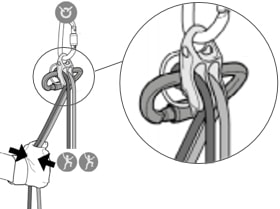
Mechanical Brake Assist DevicesThere is no difference in the functionality of the device. A brake-hand should always be on the rope to ensure the climber is caught in the case of a fall. A common guide mode setup shown below. 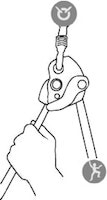
Where guide mode is used
Learn Morehttp://www.climbing.com/skill/essential-skills-auto-blocking-belay-devices/ |
1 follower only |
Teeth  TeethTeeth are only seen on tube devices. They add friction that helps grip the rope for more belaying control. This is helpful for belaying heavier climbers. Teeth are becoming standard on new tube devices. 
Worth ConsideringTeeth do wear out. You can limit wear by rappelling on the side without teeth (if you don’t need the extra friction). Once they’re worn, you’ll still have a usable belay device, just less friction. |
No |
Rope Range (mm)  Rope Range (mm)The range of rope diameters, in millimeters, that the manufacturer/brand specifies can safely be used. This is the best case scenario and does not necessarily take into consideration that certified ropes have a tolerance of +/- .3 mm. Recently, manufacturers have started to add an "optimized" rope range -- this is the range that will result in the nicest handling of the belay device. | 8.9 mm - 11.0 mm , optimized for 9.4 mm - 10.3 mm |
Certification  CertificationsThe main climbing gear certifications are CE and UIAA--and normally the UIAA creates the rules that the CE body also supports. When possible, we try to list all the certifications the product carries. To sell a climbing product in Europe, the device must be CE certified. There are no official requirements to sell climbing gear in the US. The UIAA certification is a voluntary process. Learn MoreRock and Ice Certifications Guide |
CE, EN, UIAA |
No reviews yet.
Trad, multi-pitch and big-wall climbers will find the Grigri 2 fits on a rack better than its predecessor. My only critique of the device is that when you rappel and the cam is rotated out of the housing, you can inadvertently get the rope caught in a notch between the device's frame and cam.
[Review written for the original GriGri]
There are nearly 50 different belay devices on the market, and fewer than five qualify as “auto-locking.” It says quite a bit about a Petzl Grigi that today, 18 years after its introduction to the market, it is still the gold standard for auto-locking devices. The combination of its ease of use, and effectiveness for catching falls and holding hangdogging partners, makes the Grigri the preferred device for single-pitch cragging.
How do you improve a product that has been a powerhouse in the climbing industry for almost two decades? Petzl went back to basics by making the original Grigri lighter and smaller, replacing it with the Grigri 2 (petzl.com). Used for everything from extended sport belays to jumar back-ups, the Grigri is now 2 ounces lighter and only about 75 percent of the original’s size. It also handles smaller-diameter ropes (down to 8.9mm) than the original, so skinny-rope redpointers and fat-cord topropers alike will be satisfied. From sport climbing in Colorado to a fourpitch sandstone tower in Utah, the Grigri 2 had all our testers singing its praises. Users found that feeding slack and lowering were smoother than with the original, and they ranked it as one of the most “automatic” belay devices—averaging a 9 out of 10 for braking power. We tested everything from 9.2mm to 10.5mm ropes, with the best results coming in the 9.4mm to 9.8mm range. Ropes in the 10.5mm range proved a bit balkier, but were still relatively smooth, and all rope sizes had “minimum unwanted locking.” Because the Grigri 2 is smaller than the old device, it’s also easier for those of us with childishly small hands to use the correct belay technique. One tester claimed the worst
feature of the Grigri 2 was “sending it back.”
Not to beat a dead horse (see Climbing 293), but damn, the Grigri 2 sure is nice. Everything is better than the original Grigri, which was good enough that it dominated the assisted-braking market for nearly two decades. The new Grigri is 25 percent lighter and smaller than the original, a boon for small-handed belayers especially. One tester claimed it “doesn’t get jerky like the original Grigri can.” The Grigri 2 also can handle a larger range of ropes, from 8.9mm to 11mm, which makes a big difference in an era of single lead ropes down to 8.9mm. (From our tests, the Grigri 2 handled ropes in the 9.4mm to 9.8mm range best.) Smaller, lighter, and easier to use—Version 2.0 is a great device for beginning sport climbers and seasoned pros alike. Be sure to watch the how-to-use-it video at Petzl’s website. Click here to see many more in-depth belay device reviews.
[Review written for the original GriGri]
The Petzl Grigri self-braking belay/descender device is a true industry standard. What can I say about the Grigri that has not been said over the years? Sure, some people will tell you that the Grigri does not give a dynamic belay and therefore increases forces on gear placements, blah, blah,...these are the ones still using figure-eights. However, proper use should negate this issue. I have used the Grigri to climb sport routes, long free routes and one-day ascents of El Cap; and each time, the Grigri
has facilitated our efforts. Thanks to its durability, ease of use and reliability, not to mention the diagram (for monkeys like myself), it has become for me, the most trusted belay device on the market.
While there are some folks who prefer to avoid GriGris and see them as an insult to proper climbing technique, I commend Petzl on a revolutionary design that spans the climbing world from the greenest beginner to the most experienced athlete. The GriGri2 is just another step in the right direction, building upon a legend of design. While the specific changes from the GriGri do not warrant a mandatory upgrade now, the GriGri2 will probably replace it's predecessor over time and continue to meet the tallest of climbing demands.
Pros: Best belay device ever; lighter, smaller than the first GriGri; PDC; wider range of rope diameters = 8.9mm - 11mm (instead of the older prescribed rope sizes of 10mm-11mm).
Cons: Bites more on fatter ropes; not improved enough to buy the GriGri2 before your old GriGri wears out; where's the headphone jack?
- ‹ previous
- 2 of 2
Comparison of GriGri 2 with other Petzl Belay Devices.
Warning: This video is dubbed in English. If you're getting antsy, skip to section 7:40-8:15 for one of the most interesting parts, where they show a hardware specific camera inspection.
- ‹ previous
- 2 of 2

